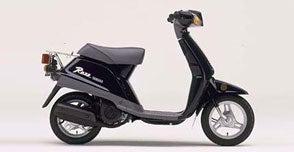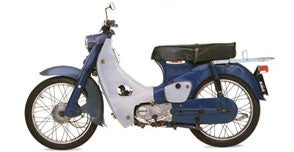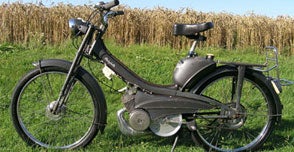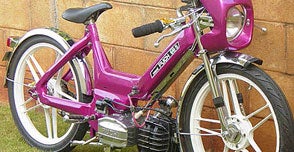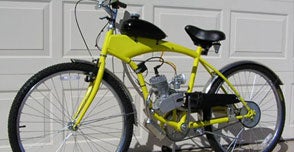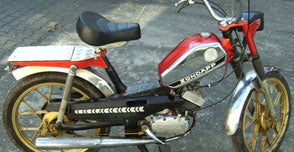|
||
| Global Moped Laws |
Local definitions of a MOPED
BrazilIn Brazil, the definition of moped ("ciclomotor" in Portuguese, but also known as "mobylette") and the regulations regarding its use has varied throughout the years. From 1985 to 1997, a moped was defined as human propulsion vehicle aided by an engine displacing less than 50 cc, no more than 3 hp, having a maximum speed of no more than 50 km/h and having pedals similar to those found in a bicycle. No license was required. CanadaIn Canada the Moped has been repealed from the Motor Vehicle Safety Regulations. Nevertheless the vehicle itself is still legislated within various provinces.
Since 28 November 2005 moped drivers require either a full M licence or a restricted class M licence to legally ride on road in Ontario. Prior to that date riders only required a G licence. The G licence is a "general" licence for automobile drivers such as cars, small vans and trucks.
DenmarkMopeds in Denmark are divided into "Small mopeds" and "Big mopeds", 'Small' mopeds have a speed limit of 30 km/h, and 'Big' mopeds have one on 45 km/h. A moped license is needed and the driver must be at least 16 to operate a small one. A car driver's or motorcycle license is needed and the driver must be at least 18 years old to drive a big one. All new mopeds (both types) bought after 1 June 2006 must be registered with a license plate, and have insurance. The older models are not required to have a license plate. Both models have a maximum of 1-1.2 bhp (750-890 W) and 50 cc but nearly 75% of all Danish mopeds are illegally unrestricted. European UnionThere is yet no law for mopeds commonly throughout the European Union; each country has its own laws. However, there is a moped called the EU-moped that has the same speeds and other properties and is widespread over Europe. It has a maximum speed of 45 km/h and must have a license plate. FinlandMopeds can be driven with an M-class driving licence, which can be obtained at the age of 15. People born before 1985 can drive a moped without a licence. The power of an internal combustion engine moped is not limited, but the speed limit is 45 km/h and engine capacity can be a maximum of 50 cc (with electric motor maximum power is restricted to 4 kW). Mopeds are allowed to carry one passenger with the driver, if the moped is registered as having two seats. Both driver and passenger are required to wear helmets. After Finland joined the European Union, EU regulations increased the maximum weight of moped and speed limit was increased from 40 km/h to 45 km/h. In Finland, it is illegal to drive a moped without a safety helmet. MalaysiaKapchai bikes may apply the same highway speed limits as cars and larger motorcycles since modern kapchai models are capable to reach the top speeds of about 120-130 km/h, therefore all kapchai bikes are allowed to be used on public roads and expressways. However in Indonesia, mopeds are not allowed on Indonesian tollways. In the Philippines, many underbones, especially the Honda XRM are modified, some are "pimped out" with stereo systems and neon lights, while others are tuned for illegal street racing. New ZealandMopeds can be driven with any class of driver licence. Mopeds are classified as having an engine capacity not exceeding 50 cc and a maximum speed not exceeding 50 km/h. Electric mopeds must have a motor between 600 and 2000 watts. Mopeds do not require safety testing (known as a Warrant of Fitness in NZ) and are subject to lower licensing costs than motorcycles, though one still needs the right equipment (Helmet etc.) But the rider must licence the moped (get plates etc)
PortugalIn Portugal Moped is a two or three wheel motor vehicle with an engine of 50 cc or less, or having an engine with more than 50 cc but with a maximum speed of no more than 45 km/h. For driving a Moped is necessary an A type licence, which can be obtained at the age of 14 years old. RussiaThe moped is legally defined as a two- or three-wheeled vehicle with engine displacement of no more than 50 cc and maximum speed of no more than 50 km/h. Such vehicles require no licensing. Pillion passengers are not allowed. Southeast AsiaIn most Southeast Asian countries, mopeds are classified as small motorcycles similar to Honda's Super Cub, sometimes called underbones, they are also known as kapchai in Malaysia. A kapchai moped is usually powered by small 2-stroke or 4-stroke engines ranging from 50 cc to 125 cc, but recently the displacement range was increased to below 150cc with the introduction of the largest displacement kapchai model, the Suzuki Raider/Satria 150R. SpainIn Spain a moped is defined as a two or three wheel motor vehicle with an engine of 50 cc or less with a maximum speed of no more than 45 km/h. The license needed for driving a moped is the 'LCC' or 'Licencia de Conducción para Ciclomotor', which can be obtained at the age of 14 years. The driver is not allowed to transport passengers on the rear seat until 16 years of age.
SwedenMopeds are available in two classes. Class 1 (also known as EU moped as it was introduced to comply with European Union rules) is a moped designed for a maximum speed of 45 km/h powered by an engine of 50 cc or, if it has an electric motor, has a maximum power of 4 kW. A driver's licence type A (motorcycle) or B (car), a driving licence for tractor or a class 1 moped licence (when you're 15 years old) is required to ride a class 1 moped. In traffic class 1 mopeds are regarded as motorcycles (but may not be driven on freeways or motorroads) and has to be registered and have a licence plate. They are however tax-free. Class 2 is a moped designed for a top speed of 25 km/h and has an engine with maximum 1 kW. No licence is required, but the driver has to be above 15 years and wear a helmet. In traffic they are regarded as bicycles unless there are signs explicitly forbidding mopeds. Mopeds registered before June 17, 2003 are called legacy mopeds and they are subject to the same rules as class 2 mopeds, but may have a top speed of 30 km/h. SwitzerlandA moped is considered to be a two-wheeled vehicle that has pedals, a motor, which is less than 50 cc and a top speed of 40 km/h. The moped must be registered and must have a number plate with a sticker for that year indicating that the vehicle is road taxed and insured. The government handles insurance. These vehicles are regarded bicycles in traffic and are therefore not allowed on motorways. To drive this vehicle one must have a Category M licence (which comes with every car and motorbike licence) as well as a motorcycle helmet. A Category M licence is obtainable at the age of 14. At the age of 16 one can obtain an A1 licence to drive a 50 cc motorcycle, which does not conform, to the 40 km/h limit. ThailandThe regulation of motorcycles in the city is different from the regulation for home use. Motorcycles in the city must have paid road tax and have a valid license plate number. However for the motorcycle for home use, a motorcycle might not need to be registered if so the motorcycle will only be able to be used in farms or a small town. Wearing helmet is a must when riding on a major road and in the city. There is no limit of maximum pillion riders on the bikes even in the city. United KingdomThe term moped describes any low-powered motor driven cycle with an engine capacity of less than 50 cc and a maximum design speed of no more than 30 mph. If used before 1 August 1977 it must be moveable by pedals and although it must be 50 cc or below, it does not have to conform to the 30mph speed restriction. (This is where the original name 'moped' is derived - Mo = motor, Ped = pedals). A provisional licence, full motorcycle or car licence is needed to operate a moped. An additional Compulsory Basic Training certificate is also required to ride a moped on public roads, except for anyone who obtained their full car driving licence or motorcycle licence before 1 February 2001. A provisional moped licence may be obtained at the age of 16, whereas standard car and motorcycles licences are only available at the age of 17. Provisional licences require learner plates and expire after two years if the licence holder has not upgraded their licence. Mopeds are subject to all of the same traffic laws as other vehicles. All motorised cycles/motorcycles/mopeds under 50 cc are excluded from using UK motorways. United StatesLegal terms and definitions of low-powered cycles vary from state to state and may or may not include "Moped," "Motorcycle," "Motorized Bicycle," "Motor scooter," "Goped," "Motor-Driven Cycle," and or others. A moped's speed generally may not exceed 30 mph (48 km/h) on level ground, even if it is capable of going faster. In a few states this number is 20 or 25 mph (32 or 40 km/h), and in most states, the maximum engine capacity is 50 cc. However, Kansas ("Motorized Bicycle" K.S.A. 8-126, 8-1439a) allows up to 130 cc[11]. Some states require pedals, while others do not. Virginia allows mopeds to operate at up to 35 mph.
VietnamMopeds can be seen everywhere. In the main cities of Hanoi and Ho Chi Minh City, mopeds are by far the preferred method of transport, due to the narrow nature of many of the streets, and the sheer volume of vehicles on them. In fact, many of the shops along these streets are designed so that these mopeds can be parked inside of the shop. |
|||||
| Last Updated ( Friday, 06 June 2008 16:55 ) |









